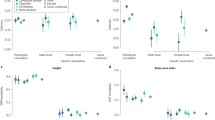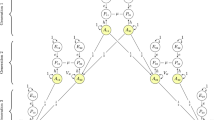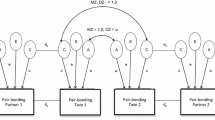Abstract
Traditional studies of mate selection have not addressed the question of how a marital correlation arises. The common assumption that assortative mating is based on phenotype has not been properly tested. Social background may be a major determinant of choice of spouse. We show how the collection of data on monozygotic (MZ) and dizygotic (DZ) twin pairs and their spouses, and estimation of all possible correlations between the twin pairs and their spouses, will allow these alternative hypotheses to be tested. Power simulations show that it will be feasible to resolve the contributions of phenotype and social background to mate selection for variables such as IQ, education, and attitudes for which the marital correlation is moderately high.
Similar content being viewed by others
References
Cattell, R. B., and Nesselroade, J. R. (1967). Likeness and completeness theories examined by 16 P.F. measures on stably and unstably married couples.J. Pers. Soc. Psychol 7:351–361.
Cavalli-Sforza, L. L., and Feldman, M. (1973). Cultural versus biological inheritance: Phenotypic transmission from parents to child.Am. J. Hum. Genet. 25:618–637.
Centers, R. (1949). Marital selection and occupational status.Am. J. Sociol. 54:530–535.
Cloninger, C. R. (1980). Intrinsic and extrinsic structural relations by path analysis: Theory and applications to assortative mating.Genet. Res. 36:135–145.
Cloninger, C. R., Rice, J., and Reich, T. (1979). Multifactorial inheritance with cultural transmission and assortative mating. II. A general model of combined polygenic and cultural inheritance.Am. J. Hum. Genet. 31:176–198.
Dobzhansky, T. (1972). Genetics and the diversity of behavior.Am. Psychol. 27:523–530.
Eaves, L. J. (1970).Aspects of Human Psychogenetics, Unpublished Ph.D. thesis, University of Birmingham, Birmingham.
Eaves, L. J. (1973). Assortative mating and intelligence: an analysis of pedigree data.Heredity 30:199–210.
Eaves, L. J. (1976a). A model for sibling effects in man.Heredity 36:205–214.
Eaves, L. J. (1976b). The effect of cultural transmission on continuous variationHeredity 37:41–57.
Eaves, L. J. (1979). The use of twins in the analysis of assortative mating.Heredity,43:399–409.
Eaves, L. J., and Heath, A. C. (1981a). On the detection of asymmetric assortative mating.Nature 289:205–206.
Eaves, L. J., and Heath, A. C. (1981b). Sex-limitation and asymmetric assortative mating. In Gedda, L., Parisi, P., and Nance, W. E. (eds.),Twin Research 3: Intelligence, Personality and Development, Alan R. Liss, New York.
Eaves, L. J., Last, K. A., Young, P. A., and Martin, N. G. (1978). Model-fitting approaches to the analysis of human behavior.Heredity 41:249–320.
Feingold, L. F. (1984). Unpublished D. Phil. thesis, University of Oxford, Oxford.
Greig, D. M. (1980).Optimisation, Longman, London.
Hayley, C. S. and Last, K. (1981). The advantages of analyzing human variation using twins and twin half-sibs and cousins.Heredity 47:221–236.
Heath, A. C. (1983). Unpublished D. Phil. thesis, University of Oxford, Oxford.
Heath, A. C., and Eaves, L. J. (1984). Elements of a general linear model of assortative mating (submitted for publication).
Heath, A. C., Berg, K., Eaves, L. J., Solaas, M. H., Sundet J., Nance, W. E., Corey, L. A., and Magnus, P. (1984). No decline in assortative mating for educational level (submitted for publication).
Jensen, A. R. (1978). Genetic and behavioral effects of nonrandom mating. In Osborne, R. T., Noble, C. E., and Weyl, N. (eds.),Human Variation: The Biopsychology of Age, Race and Sex, Academic Press, New York.
Links, J. L., and Fulker, D. W. (1970). Comparison of the biometrical genetical, MAVA and classical approaches to the analysis of human behavior.Psychol. Bull. 73:311–349.
Johnson, R. C., Ahern, F. M., and Cole, R. E. (1980). Secular change in degree of assortative mating for ability?Behav. Genet. 10:1–8.
Joreskog, K. G. (1978). Structural analysis of covariance and correlation matrices.Psychometrika 43:443–477.
Loehlin, J. C. (1978). Heredity-environment analyses of Jenck's IQ correlations.Behav. Genet. 8:415–426.
Lytton, H. (1977). Do parents create, or respond to, differences in twins?Dev. Psychol. 13:456–459.
Martin, N. G., Eaves, L. J., Kearsey, M. J., and Davies, P. (1978). The power of the classical twin study.Heredity 40:97–116.
Mather, K. (1966). Variability and selection.Proc. Roy. Soc. Ser. B 164:328–340.
Nance, W. E., and Corey, L. A. (1976). Genetic models for the analysis of data from the families of identical twins.Genetics 83:811–826.
Numerical Algorithms Group (1978).Fortran Library Manual, Mark 7, NAG, Oxford.
Pearson, E. S., and Hartley, H. O. (eds.) (1972).Biometrika Tables for Statisticians, Vol. 2, Cambridge University Press, Cambridge.
Rao, D. C., Morton, N. E., and Yee, S. (1976). Resolution of cultural and biological inheritance by path analysis.Am. J. Hum. Genet. 28:228–242.
Rao, D. C., Morton, N. E., Elston, R. C., and Yee, S. (1977). Causal analysis of academic performance.Behav. Genet. 7:147–159.
Rao, D. C., Morton, N. E., and Cloninger, C. R. (1979) Path analysis under generalized assortative mating. I. Theory.Genet. Res. 33:187–198.
Rice, J., Cloninger, C. R., and Reich, T. (1980). Analysis of behavioral traits in the presence of cultural transmission and assortative mating.Behav. Genet. 10:73–92.
Thomas, J. L. (1951). The factor of religion in the selection of marriage mates.Am. Sociol. Rev. 16:487–491.
Warren, B. L. (1966). A multiple variable approach to the assortative mating phenomenon.Eugen. Q. 13:285–290.
Wright, S. (1934). The method of path coefficients.Ann. Math. Stat. 5:161–215.
Wright, S. (1968).Evolution and the Genetics of Populations, Vol. 1 Chicago University Press, Chicago.
Wright, S. (1978).Evolution and the Genetics of Populations, Vol. 2, Chicago University Press, Chicago.
Young, P. A., Eaves, L. J., and Eysenck, H. J. (1980). Intergenerational stability and change in the causes of variation in personality.Personal Indiv. Diff. 1:35–55.
Author information
Authors and Affiliations
Additional information
Research reported in this paper was supported by a postgraduate studentship to ACH from the United Kingdom Medical Research Council and by Grants GM30250 and HL28922 from the National Institutes of Health. We are grateful to Drs. N. G. Martin, C. R. Cloninger, D. C. Rao, and W. E. Nance for helpful comments on early drafts of this paper.
Rights and permissions
About this article
Cite this article
Heath, A.C., Eaves, L.J. Resolving the effects of phenotype and social background on mate selection. Behav Genet 15, 15–30 (1985). https://doi.org/10.1007/BF01071929
Received:
Accepted:
Issue Date:
DOI: https://doi.org/10.1007/BF01071929




